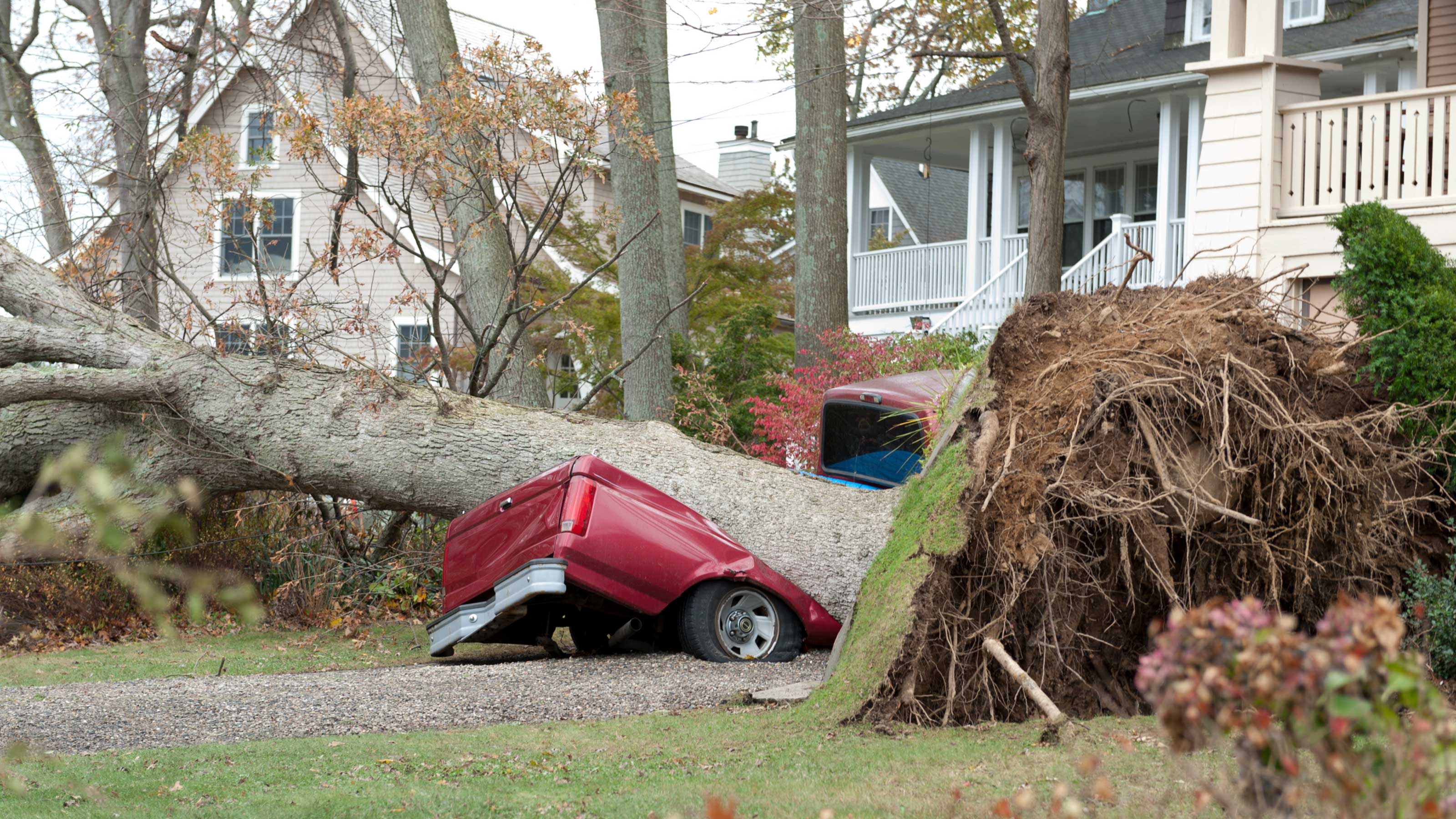Tax Relief for Hurricane, Wildfire, Flood and Other Natural Disaster Victims
Deductions for lost or damaged property, filing and payment extensions, and fee waivers can help taxpayers hit by a hurricane, wildfire, tornado, earthquake, flood or other natural disaster.


When a natural disaster hits, staying safe and finding food, water, shelter and other necessities are the top priorities for people directly affected by Mother Nature's outburst. Eventually, however, natural disaster victims will also have to worry about insurance claims, lost wages and other financial issues.
Fortunately, when it comes to taxes, there's some relief available for those left with property damage and lost records in the wake of a hurricane, wildfire, tornado, earthquake, flood or similar natural catastrophe.
Deduction for Damaged or Lost Property
An important tax break for natural disaster victims is the casualty loss deduction for damage to your home, car or personal belongings. Generally, the deduction is equal to either the property's adjusted basis or decreased value, whichever amount is smaller, less insurance proceeds. Unfortunately, however, there are some limitations and offsets that hurricane victims need to know about before trying to claim the deduction. But there are also some special rules on when you can claim the deduction that could save you some money.

Sign up for Kiplinger’s Free E-Newsletters
Profit and prosper with the best of expert advice on investing, taxes, retirement, personal finance and more - straight to your e-mail.
Profit and prosper with the best of expert advice - straight to your e-mail.
Limits and Offsets
First, for individuals, a property loss is deductible only to the extent it's attributable to a federally declared disaster. So, if your lost or damaged property isn't in a federally declared disaster area, then you probably can't take the deduction. The Federal Emergency Management Agency (FEMA) has a list of federally declared disasters and disaster areas on its website.
You must also itemize and file Schedule A with your tax return to write off disaster losses. If you claim the standard deduction instead, you can't deduct your losses unless you can claim them as business losses on Schedule C.
If you receive an insurance or other type of reimbursement (such as government assistance), you have to subtract the reimbursed amount when you calculate your loss. Also subtract any expected reimbursement if you haven't received payment yet. If your property is covered by insurance but you don't file an insurance claim, only the part of the loss that isn't covered under your policy is deductible.
Finally, once the eligible loss is calculated, you have to subtract $100 per disaster and then 10% of your adjusted gross income. For example, if you have $20,000 in unreimbursed losses and your AGI is $100,000, you will first subtract $100. Then, you will subtract $10,000 (10% of your AGI) from the $19,900 balance. The remaining $9,900 is the amount you can deduct on Schedule A of your tax return. (The $100 and 10% reductions don't apply to deductions for lost or damaged business or income-producing property.)
Use IRS Form 4684 to calculate your deductible disaster losses, and then carry the amount over to Schedule A. Check out IRS Publication 547 for more information on calculating and writing off disaster losses.
[Note: Victims of 2019 federally declared natural disasters can deduct qualified losses without itemizing. Losses from 2019 disasters don't need to exceed 10% of AGI, either. However, the $100-per-casualty limit is increased to $500 for 2019 disasters. If you requested a filing extension for your 2019 tax return, you have until October 15, 2020, to claim the deduction for a 2019 disaster using these special rules.]
When to Claim the Deduction
As you might guess, you can claim the casualty loss deduction for the tax year that the loss occurs. However, if you want, you can claim the deduction for the previous tax year instead. For instance, you can claim losses from a 2020 natural disaster on your 2020 or 2019 tax return. Pick whichever year is more favorable to you. Claiming the deduction on the previous year's return could mean you get some money back sooner rather than later in the form of a refund of taxes paid on your prior year return. That could make a big difference when you're trying to get back on your feet after a natural disaster.
If you already filed your return for the previous tax year, you can claim the deduction for that year by filing an amended return on Form 1040X. However, the amended return must be filed no later than six months after the due date for filing your original return (without extensions) for the year in which the loss took place. So, for example, if you're claiming a deduction for property damaged by a 2020 natural disaster on an amended 2019 return, you must file the amended return by October 15, 2021.
Extensions for Filing Returns and Paying Taxes
When there's a federally declared disaster, the IRS typically postpones tax filing and payment deadlines for affected taxpayers. The extensions usually apply to a wide variety of tax filings and payments, including estimated income tax payments and original tax returns extended until October 15. Also expect the IRS to waive late filing and late payment penalties if returns are filed or payments are made before the extended due dates.
This type of tax relief is available for taxpayers who are not physically located in a federally declared disaster area, but whose records necessary to meet a filing or payment deadline are in a covered area. To receive tax relief, people outside of the declared disaster area must identify themselves by calling the IRS at 866-562-5227.
Waiver of Fees for Previous Tax Returns
Reconstructing records after a disaster is an essential task for tax purposes, getting federal assistance or insurance reimbursement. After a disaster, certain records will be needed to prove your loss. For tax records, the IRS usually waives the fees and expedites requests from disaster victims for copies of previously filed tax returns or return summaries known as a "tax transcripts." You can request these by filing either Form 4506 (copy of return) or Form 4506-T (transcript). Write the assigned disaster designation (e.g., "Hurricane _____") in red ink at the top of the form. You can also request a transcript online at irs.gov/individuals/get-transcript.
You'll want a copy or transcript of your previous year's return if you're claiming a disaster-related casualty loss deduction for that tax year and you no longer have copies of your original return. You'll also need new copies or transcripts for other tax years for your records if your original copies are lost or destroyed by the natural disaster.
The IRS has additional tips for reconstructing records after a disaster on its website.
State Tax Relief for Disaster Victims
State tax relief may also be available to people and businesses affected by a natural disaster. It usually comes in the form of filing and payment extensions and/or penalty and interest waivers. State tax relief often extends to residents of other states who have a tax obligation in the state providing the relief (e.g., Georgia could provide relief for Florida residents who pay Georgia taxes). Check with the state tax agency where you live to see what tax relief is available for victims of natural disasters.
Pre-Disaster Preparation
It's a good idea to plan ahead before disaster strikes – especially if you live in an area prone to hurricanes, tornados or other frequent natural disasters. For instance, make sure you secure original documents such as tax returns, birth certificates, deeds, titles and insurance policies in a waterproof and/or fireproof container. Give duplicates to a relative or other trusted person who lives in a different town or state. You also might want to download important documents to a flash drive so you have an electronic copy (and, of course, keep the flash drive in a secure place like a safe deposit box).
Having current photos or videos of your home and its contents is another smart move. They can help support claims for insurance or tax benefits after a natural disaster. It's especially useful to do this for expensive and high value items.
Also consider using the disaster-loss workbooks in IRS Publication 584 to compile lists of your belongings. They're designed to help you determine your loss on your main home, its contents and your motor vehicles following a disaster.
Get Kiplinger Today newsletter — free
Profit and prosper with the best of Kiplinger's advice on investing, taxes, retirement, personal finance and much more. Delivered daily. Enter your email in the box and click Sign Me Up.
Rocky Mengle was a Senior Tax Editor for Kiplinger from October 2018 to January 2023 with more than 20 years of experience covering federal and state tax developments. Before coming to Kiplinger, Rocky worked for Wolters Kluwer Tax & Accounting, and Kleinrock Publishing, where he provided breaking news and guidance for CPAs, tax attorneys, and other tax professionals. He has also been quoted as an expert by USA Today, Forbes, U.S. News & World Report, Reuters, Accounting Today, and other media outlets. Rocky holds a law degree from the University of Connecticut and a B.A. in History from Salisbury University.
-
 Do You Want An Extra $50,000 In Your 401(k)? Delay Retiring
Do You Want An Extra $50,000 In Your 401(k)? Delay RetiringDon’t think putting off retiring for six months to a year will have a meaningful impact? Think again. See how much it can help.
-
 Ten Cheapest Places To Live in New York
Ten Cheapest Places To Live in New YorkProperty Tax If you’re planning a move in New York, here are the counties with the lowest property tax bills in the Empire State.
-
 Ten Cheapest Places To Live in New York
Ten Cheapest Places To Live in New YorkProperty Tax If you’re planning a move in New York, here are the counties with the lowest property tax bills in the Empire State.
-
 ‘My Etsy Shop is Dead’: Vendors Cry for Help Amid Trump’s Tariffs
‘My Etsy Shop is Dead’: Vendors Cry for Help Amid Trump’s TariffsTariffs Small businesses are struggling to thrive as they absorb the Trump administration’s new wave of tariffs.
-
 New HSA Contribution Limits Are Set for 2026: What to Know Now
New HSA Contribution Limits Are Set for 2026: What to Know NowHealth Savings The IRS says Health Savings Account contribution limits will increase again next year due to inflation.
-
 Ask the Editor, May 4 — Questions on Tax Deductions, Losses
Ask the Editor, May 4 — Questions on Tax Deductions, LossesIn our Ask the Editor series, Joy Taylor, The Kiplinger Tax Letter Editor, answers readers' questions on tax deductions and losses.
-
 Three Things Star Wars Fans Taught Me About Tax
Three Things Star Wars Fans Taught Me About TaxTax Tips May the force be with you and your taxes this Star Wars Day 2025.
-
 The IRS is in Chaos
The IRS is in ChaosThe Tax Letter DOGE, departures, data agreements and more are creating havoc at the IRS.
-
 Retirees: Don’t Miss These Valuable State Tax Breaks in 2025
Retirees: Don’t Miss These Valuable State Tax Breaks in 2025Retirement Planning Selecting the right state for retirement can significantly impact your financial well-being.
-
 Ask the Editor: Reader Questions, April 25 — 529 plans
Ask the Editor: Reader Questions, April 25 — 529 plansIn our latest Ask the Editor round-up, Joy Taylor, The Kiplinger Tax Letter Editor, answers questions related to 529 plans.